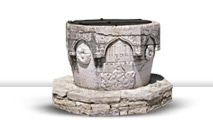
- Sečovlje Salt Pans - Dragonja River Valley
- Sv. Peter - Nova vas - Padna
- Pomjan - Nature Park: Karst Edge - Socerb
- Črni Kal - Osp - Kubed
- Momjan - Grožnjan - Pietrapelosa - Mirna
- Baštija - Kostanjica - Parenzana
- Oprtalj - Završje - Livade - Zrenj
- Istarske toplice - Motovun Forest - Višnjan
- Cave Mramornica - Feštini Kingdom - Cave Baredine
- Lim Bay - Kloštar - Kontija - Dvigrad
- Kanfanar - Bale - Palud - Vodnjan - Brijuni - Fažana
- Svetvinčenat - Tinjan - Pićan - Gračišće
- Belaj - Šumber - Kožljak - Paz
- Čepićko Field - Kršan - Boljun Castle - Lupoglav
- Plomin - Kvarner Gulf - Brseč
- Nature park Učka - Mošćenice
Nature park Učka - Mošćenice
Učka nature park
At first glance, simply a mountain connecting Istria with the continental part of the country. However, it has always been much more than this. Both in terms of nature and history.
The closeness of the sea and mountain relief created a climate for special and luxuriant vegetation. In addition to the natural beauties, high peaks, canyons, vast meadows, 40 ponds, 200 caves, water springs and abundant forests, the area is rich with rare plant and animal species. On an area stretching 160 square kilometers with the highest peak Vojak (1,401 m above sea level) there are 160 bird species, 249 butterfly species of which 163 nocturnal, 20 species of amphibians and reptiles, 18 species of bats and many other special features of fauna. Its flora is just as attractive, with its many rare and protected specimens of flowers and different plants. Učka abounds in forests of beech and hornbeam, as well as afforested holm-oak and unavoidable vast forest of the far-famed sweet chestnut.
Such epithets of Učka are just some of the precious features and values, areas that will be of great interest of the public institution that manages Učka Nature Park.
The very beginnings of human existence can be traced back 12,000 years, to the end of the Ice Age, when the Adriatic was just a bay reaching somewhere to present-day Zadar, and its northern part was a fertile plain with a diversity of beasts and game. As the sea level rose by some 120 meters, the inhabitants moved to higher areas and started living in caves, today the oldest archaeological sites from that time in Croatia (Pupićina and Vela caves in Vela draga). The mountains were inhabited by the Histri and Liburnians, since this was also the borderline of their property, natural defense against many incursions, and battles as well. Later, the development of cattle breeding, metal work and trade created new living conditions. The peaceful period under the Roman Empire was soon interrupted by barbarian incursions which led to the building of fortifications and refuges. Smaller urban centers were also fortified, which later grew into medieval communes like Brseč, Mošćenice, Lovran and Veprinac. In the 10th c. Učka was the border between the Kingdom of Croatia and the Frankish Empire. In the following centuries this area was also the cause of battles and demarcation between many countries and feudal rulers who followed each other on the territory of Istria and Liburnia. At the end of the Middle Ages, in the 15th c. the Vlachs migrated to the mountainous parts of Istria ravaged by the plague. They were later known as Ćići or Istro-Romanians. They brought their characteristic language and specific shepherd's tradition, and considerably contributed to the development of local culture and way of life.
The Austro-Hungarian rule introduced a new dimension, and the development of tourism in the coastal region embraced Učka as an excursion destination. During World War II the mountain served as a safe refuge, but also as a battle site. After the war and in search of employment, the majority of population moved to towns. Villages were half-empty and the one-time rich life came to a standstill. However, recently Mount Učka returns to life again with the tourist and ethnographic events that draw new visitors with such an attractive offer.
Напечатай страницу Отправь другу
















